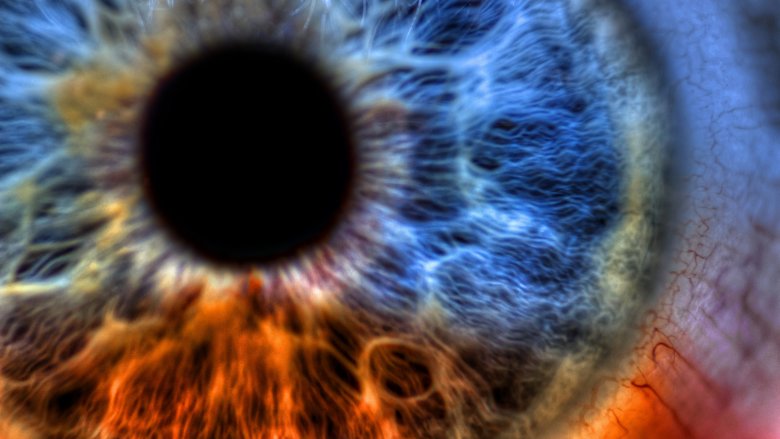Things We Believed About Mental Illness That Ended Up Being Wrong
We may receive a commission on purchases made from links.
We've come a long way as a species, and while we may no longer believe it was a mental illness (so-called drapetomania) that made slaves want to run away to freedom, we've still got a long way to go when it comes to erasing the stigma around mental illness. According to the National Alliance on Mental Illness, those who are living with any one of a number of diagnoses are still subjected to ridicule, shame, and contempt. Based on what we used to believe they were dealing with, it's no wonder. Let's take a look at the history, lay out some completely bogus beliefs, and maybe understand a little more about why that stigma is unfounded.
Depression could be released through a hole in the head
The World Health Organization estimates more than 300 million people suffer from depression and nearly 800,000 commit suicide as a consequence every year. Those are numbers that have been high for as long as people have had things to be depressed about. (Forever.) Treatment options go back just as far. At one point, we were treating depression by hacking a hole in a person's skull.
It was called trepanning, and according to an article in The Neuroscientist, there are a lot of reasons we felt it necessary to put a hole in someone's head. Sure, we did it in cases of severe head injury, but starting with ancient Greek physicians, we also did it to release the bad vapors supposedly building up inside the skull. In 1170, Roger of Parma wrote patients should be chained while "the cranium is penetrated, to permit the noxious material to exhale to the outside."
Trepanning for depression only fell out of favor in the 18th century. Let that sink in for a minute. There were different ways a person could be trepanned, and while some involved using a sharp knife to create a series of intersecting cuts to remove the skull, another method involved scraping away at the bone with a piece of flint. It could take about an hour to scrape through the skull, so it's no wonder people denied they were depressed.
Hallucinations and mental illness came from the gods
The NHS says today we associate hallucinations with things like bipolar disorder and schizophrenia, medical conditions like Parkinson's, or temporary conditions like exhaustion. William Harris, Columbia University professor and editor of Mental Disorders in the Classical World (via New Republic), says the ancient Greeks and Romans left a pretty detailed record of some of the things they hallucinated about, and why they believed they were seeing and hearing these things. For example, Galen wrote about a man who heard flutes playing in his house 24/7, which not even flute players want to hear. Harris says there were differing views on what caused hallucinations, and many people thought they were messages from the gods.
He told The Atlantic hallucinations were thought to be a sign that the gods had taken offense to something a person had done, and if you're familiar with Greek and Roman mythology, you'll know they took offense to a lot of things. There were other ideas; the Epicureans, for example, decided the world was made of material, not godly, things. Hallucinations were simply the brain overloading on the information it was collecting from the atoms that whizzed around in the air, according to them.
Physicians struggled to overcome all of these beliefs, insisting hallucinations had a physical cause ... they just weren't sure what. That went over as well back then as it does now.
PTSD was actually a cardiac condition
The U.S. Department of Veterans Affairs says there's been documentation of what we now call PTSD for as long as there have been written records. We've only recently started to understand it as stemming from traumatic experiences, and it's had a whole host of names. In 18th-century Europe, it was even written off as nostalgia or a powerful homesickness. With the start of the U.S. Civil War, a new group of medical professionals started looking at it. They called it either soldier's heart, irritable heart, or Da Costa's syndrome, after the doctor who declared the symptoms all developed from a heart condition.
We're only really rediscovering this now, with work done by the National Museum of Civil War Medicine (via the Smithsonian). Researchers, historians, and mental health experts have been sifting through scores of documents to find heartbreaking descriptions of people suffering from what we now know as PSTD, then diagnosed as a physical ailment. They wrote of heart palpitations, nervousness, trouble breathing, and a rapid pulse, and diagnosed causes like exertion or knapsack straps that were too tight. Nostalgia was still a common diagnosis, too. Treatment was ... iffy. Sometimes it was public shaming, sometimes it was discharge from the military, and sometimes it was "the excitement of an active campaign." That absolutely means what you think it means: soldiers who were already suffering were sent right back into combat.
There's a definite link between violence and mental illness
You hear it all the time, especially when there's been a mass shooting or some other tragedy. Mental illness is one of the first things mentioned, which has given rise to the idea of a link between mental illness and violence. It's a modern myth, and even though we know it's not true, it's still repeated over and over. Let's try to clear that up, with help from Joel Dvoskin, Ph.D. — a clinical psychologist who has a resume that includes things like working with the U.S. Secret Service, Psychologists in Public Service, and the American Bar Association Task Force on Capital Punishment and Mental Disability (via the American Psychological Association). He knows what's what, and he says the idea that a mentally ill person is definitely going to be violent is "very inaccurate and, in fact, counterproductive and harmful."
He says while there are people diagnosed with a mental illness who commit crimes, it's a statistically small percentage. There are a ton of other factors that are more important — like alcohol and substance abuse — when it comes to putting together a risk assessment. So no, mental illness does not equal violence, and when it does happen, it's a series of factors coming together in a "perfect storm of despair." Dvoskin even says the risk of a person with schizophrenia killing a stranger is about 1 in 144,000, so this is clearly another myth we need to stop believing.
Mental illness had roots in bodily infection
In the late 19th century, Bayard Holmes turned from homeopathic medicine to surgery to psychiatry after his son was diagnosed with what we now call schizophrenia (then called dementia praecox). Discover says Holmes was obsessed with finding the cause and the cure, and he concluded that mental illness had roots in a physical problem. In his son's case, he believed it was an intestinal blockage that was causing the body to go into overdrive in the production of histamine. His cure? Open up his son's intestines and wash them out ... daily, until cured.
Not surprisingly, his son died from the treatment. A few years later Dr. Henry Cotton picked up the torch. He was head of Trenton State Hospital in New Jersey, and an absolute believer in bacterial autointoxication. His prescriptions for his mentally ill patients involved pulling teeth and removing things like colons, thyroids, gall bladders, and tonsils. He personally performed 645 colectomies (for things like manic-depression) and also removed the teeth of his wife and sons as a preventative measure. (Both sons later committed suicide.)
The Atlantic says he pulled more than 11,000 teeth over the course of his career. He even pulled some of his own when he became convinced he was developing a mental illness, and he ultimately died of a heart attack in 1933.
All mental illness is a single condition
Sounds like a pretty bizarre idea, right? According to Schizophrenia Is a Misdiagnosis, the idea first showed up in the writings of Belgian psychiatrist Joseph Guislain in the 1850s. He didn't name the theory, but he did say mental illness was an ever-evolving state where a person would experience everything from mania to depression to delirium, all based on whatever external stimulus they were exposed to. When his work was translated it was given the name "unitary psychosis theory," and it found plenty of support in the mental health community.
Supporters believed the idea of different mental illnesses needed to be scrapped completely because there was only the one. Heinrich Neumann wrote, "We should throw it all overboard. ... There is only one form of mental illness, that is insanity, which does not have different forms but different stages."
Others added the idea that different symptoms were experienced along the road of mental illness, a road that ended with dementia. Bizarre? Absolutely.
The full moon makes symptoms worse
You know the story. You or someone you know might even swear it's true. The full moon has been linked to all sorts of things, from werewolves and an increase in violence to the worsening of the symptoms of mental illness. It goes back to ancient Rome, so you know we've had plenty of time to look at whether it's true. It's not.
The belief is rooted in the idea that the full moon exerts extra forces on us, and starting at a scientific level, it's just not true. Scientific American quotes UCLA astronomer George Abell as saying we feel a greater gravitational force from a mosquito landing on us than from a full moon, so there's that, uh ... science. That's the same science that points out a new moon has all the same (negligible) gravitational effects as the full moon.
Psychologists have still looked at whether there's evidence for this age-old belief, and they couldn't find any either. All kinds of studies and data were combined into a massive meta-analysis by several prominent universities in 1985, and it found nothing to indicate the full moon has any impact on mental illness at all. Turns out you can't believe everything you see on television.
Mental illness could be cured by damaging the brain
If you were to make a list of all the things that sound like a really bad idea, sticking an ice pick in your eye and then swirling it around in your brain is probably on the list. That's exactly what a lobotomy is, and if you're thinking "That doesn't sound very scientific," congrats, you have critical thinking skills. According to writer Jack El-Hai (via Motherboard), lobotomies were popularized by Walter Freeman, who performed more than 3,500 surgeries with a technique he created with the help of electroshock anesthetic and an ice pick he grabbed from his own kitchen. (Hopefully he didn't put it back after upgrading his tools.)
El-Hai, who also wrote a biography of Freeman, said Freeman believed unwanted behaviors and emotions could be destroyed by severing the connections between different sections of the brain. He even did it as a preventive measure. (It went very poorly. Do not try this at home.)
El-Hai wrote that Freeman was doing this all out of genuine concern for his patients, trying to make life better for them. He was also more efficient than Antonio Egas Moniz, who was the first one to perform the technique. Wired says he did it a little differently, drilling some holes in the skull then injecting pure alcohol into the brain to destroy those connections. Don't try that at home, either.
The spread of mental illness could be stopped be sterilization
There's nothing wrong with wanting to put an end to mental illness — we can agree everyone would like to see that happen. But starting in the early 20th century, there was a shocking belief that end could be achieved through some horrible means: forcibly sterilizing the mentally ill.
According to the LA Times, U.S. eugenics laws meant about 64,000 people were sterilized against their will by the time the whole awful thing was outlawed. There were different reasons for the procedure — one 1927 Supreme Court case involved a forced sterilization done for reasons of "race betterment" — but mental illness was a big one. About half of California's 20,000-plus sterilizations were done on people diagnosed as either schizophrenic or manic-depressive. Alexandra Minna Stern, Ph.D., from the Center for the History of Medicine at the University of Michigan, says the procedure was a legitimate option if it was thought it would improve the patient's "physical, mental, or moral condition."
That's a lot of wiggle room to shoehorn in a really bad idea. According to Mad in America, it was all rooted in the debate over whether mental illness is nature or nurture. Sure, maybe we haven't proven an answer to that question yet, but we know forced sterilizations aren't the way to stop it from spreading. It's a bad idea, like pretty much all of Hitler's ideas.
Mental illness was caused by an imbalance of the humors
One of the earliest theories about what caused mental illness is also one of the longest-lasting. According to the British Columbia Medical Journal, belief that an imbalance in the body's four humors — black bile, yellow bile, blood, and phlegm — could cause physical and mental illness lasted from the ancient Egyptians and Greeks until at least the late 19th century.
Matthew Smith, Ph.D. (via Psychology Today) writes that if you were depressed, you were thought to have too much black bile. If you had issues with aggression, you had too much yellow bile. Anyone who was detached and unable to connect with people on an emotional level had too much phlegm.
Now, there's definitely something to be said about creating a balance in your life, since it's no secret that all work and no play is a stupid way to live. It's entirely possible that a reexamination of your life could help your mental state, which is basically what we call therapy today. The Gulf Bend Center says early treatments went farther than just recommending rest, relaxation, and fresh air, though. Our ancestors used things like starvation, beatings, bloodletting, and even gymnastics to treat mental illness. We're all for taking a mental health day every so often, but bloodletting? You first, Doc.










